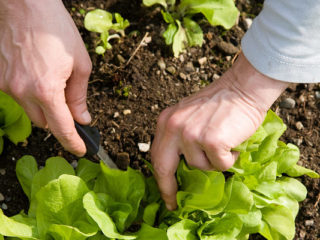Diabetes Management: A Guide to Growing Your Own Food
For the more than 100 million people in the United States living with diabetes, managing this chronic disease can be a challenge. The meaning of mealtimes may shift. Instead of being moments of relaxation and enjoyment, they can become ones of stress and number crunching, turning eating into a less pleasurable experience for you and your loved ones. However, through hands-on creativity, you can transform diabetes management into a therapeutic activity.
Growing Diabetes-Friendly Food
Diabetes management requires identifying which foods contain carbohydrates and quantifying how many of those foods you can eat per meal. This can be a real headache for many, deterring some from properly managing their blood sugars. The problem has been inspiring health professionals to envision more enjoyable ways for patients to tackle their diabetes.
When Lois Weiss, the diabetes program coordinator at Dignity Health Medical Group – St. Mary’s Medical Center, started a small vegetable garden at the hospital, her goal was to show patients that despite living in a city, they too can grow their own healthy, diabetes-friendly foods in a small space. “Eating more food harvested from the ground and less processed foods from packages should be a staple for diabetics’ diets,” Weiss says. “Not only does growing your own food help you eat better, but digging in the dirt has other health benefits including exercise and stress reduction, which are vital to controlling diabetes.”
Through harvesting your own veggies, you’ll end up bolstering your diet with low-carbohydrate foods, reducing the temptation to have too many carbs at a given meal.
Methods for At-Home Growing
Whether you live in a house on a big piece of land, a townhome, or even an apartment without good sunlight, there are options for growing produce at home.
- Raised Bed and In-Ground Gardens: If you have a yard, you can plant fruit, veggie, and herb plants in the ground, or create raised beds out of wood planks. To get started, Lois recommends planting vegetables like snap peas, lettuce, and other types of greens, which are very forgiving for beginners to grow.
- Window Boxes and Potted Plants: If your home doesn’t boast a yard but has a sunny window or balcony space, potted planters and window boxes are great ways to try your hand at growing food. Herbs do very well in pots or window boxes, as do strawberries, lettuce, radishes, and green onions.
- At-Home Hydroponics: If you don’t have much direct sunlight at your place, even that doesn’t prohibit you from growing produce in your home! At-home hydroponic kits — with which you can grow herbs and lettuce in nutrient-rich water under a specialty lighting system — are available. These smart garden units are remarkable, notifying you when it’s time to add more nutrients and water, and they even automatically turn on and off the lighting system when appropriate.
- Community Gardens: If you absolutely don’t have space for a garden of your own, many neighborhoods or towns have their own community gardens where you can help tend and enjoy a bounty from.
While diabetes management can seem like a burden, there are many ways to transform it into a therapeutic and even fun activity. Gardening not only helps you grow the healthy foods that comprise a diabetic diet but also provides a setting in which you can unwind and burn some calories. As Weiss expresses, “We hope that through gardening, patients will develop more interest in learning about their food choices, and start to prepare fresh, healthy food at home.”

